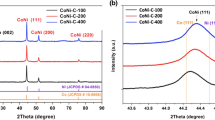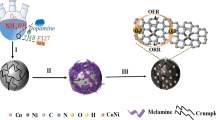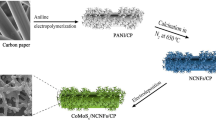Abstract
The development of heteroatoms doped inorganic nanocrystal-carbon composites (INCCs) has attained a great focus for energy applications (energy production and energy storage). A precise approach to fabricate the INCCs with homogenous distribution of the heteroatoms with an appropriate distribution of metal atoms remains a challenge for material scientists. Herein, we proposed a facile two-step route to synthesize INCC with doping of metal (α-Fe2O3) and non-metals (N, P, O) using hydrogel formed by treating hexachlorocyclotriphosphazene (HCCP) and 3, 4, 5-trihydroxy benzoic acid (Gallic acid). Metal oxide was doped using an extrinsic doping approach by varying its content and non-metallic doping by an intrinsic doping approach. We have fabricated four different samples (INCC-0.5%, INCC-1.0%, INCC-1.5%, and INCC-2.0%), which exhibit the uniform distribution of the N, P, O, and α-Fe2O3 in the carbon architecture. These composite materials were applied as anode material in water oxidation catalysis (WOC); INCC-1.5% electro-catalyst confirmed by cyclic voltammetry (CV) with a noticeable catholic peak 0.85 V vs RHE and maximal current density 1.5 mA.cm−2. It also delivers better methanol tolerance and elongated stability than RuO2; this superior performance was attributed due to the homogenous distribution of the α-Fe2O3 causing in promotion of adsorption of O2 initially and a greater surface area of 1352.8 m2/g with hierarchical pore size distribution resulting higher rate of ion transportation and mass-flux.
Graphical abstract









Similar content being viewed by others
Data availability
No relevant data is present for this study.
References
Centi G, Quadrelli EA, Perathoner S (2013) Catalysis for CO2 conversion: a key technology for rapid introduction of renewable energy in the value chain of chemical industries. Energy Environ Sci 6(6):1711–1731
Yang J et al (2022) Green preparation and supercapacitive behaviors of calcium carbide derived porous carbon based on solvent-free mechanochemical route. J Energy Storage 51:104473
Ge R, Chen L (2022) Ultra-small RuO2 nanoparticles supported on carbon cloth as a high-performance pseudocapacitive electrode. Adv Compos Hybrid Mater 5:696–703
Parent AR, Crabtree RH, Brudvig GW (2013) Comparison of primary oxidants for water-oxidation catalysis. Chem Soc Rev 42(6):2247–2252
Wang Y et al (2021) Industrially promising IrNi-FeNi3 hybrid nanosheets for overall water splitting catalysis at large current density. Appl Catal B 286:119881
Dong C et al (2018) Eutectic-derived mesoporous Ni-Fe-O nanowire network catalyzing oxygen evolution and overall water splitting. Adv Energy Mater 8(5):1701347
Deng X, Tüysüz H (2014) Cobalt-oxide-based materials as water oxidation catalyst: recent progress and challenges. ACS Catal 4(10):3701–3714
Yagi M, Kaneko M (2001) Molecular catalysts for water oxidation. Chem Rev 101(1):21–36
Yang X, Baik M-H (2008) The Mechanism of Water Oxidation Catalysis Promoted by [tpyRu (IV) O] 2 L3+: a Computational Study. J Am Chem Soc 130(48):16231–16240
Deng F, Jiang J, Sirés I (2022) State-of-the-art review and bibliometric analysis on electro-Fenton process. Carbon Letters, 1–18
Li F et al. (2022) Modulation of the lattice structure of 2D carbon-based materials for improving photo/electric properties. Carbon Letters, 1–11.
Wang J et al. (2022) Recent advances of MXenes Mo2C-based materials for efficient photocatalytic hydrogen evolution reaction. Carbon Letters 1–14.
Yang M et al (2022) Correction to: Solvothermal preparation of CeO2 nanoparticles–graphene nanocomposites as an electrochemical sensor for sensitive detecting pentachlorophenol. Carbon Letters, 1–1.
Mayes RT et al. (2015) Metal-carbon composites and methods for their production. Google Patents.
Miao Z et al (2022) New flame retardant epoxy resins based on cyclophosphazene-derived curing agents. Chin Chem Lett 33(8):4026–4032
Ueno T et al (2009) Highly thermal conductive metal/carbon composites by pulsed electric current sintering. Synth Met 159(21–22):2170–2172
Liang J et al. (2022) Hollow hydrangea-like nitrogen-doped NiO/Ni/carbon composites as lightweight and highly efficient electromagnetic wave absorbers. Nano Research 1–10
Datta K et al (2008) Synthesis of agarose-metal/semiconductor nanoparticles having superior bacteriocidal activity and their simple conversion to metal-carbon composites. J Chem Sci 120(6):579–586
Wei X et al (2022) Design of Functional Carbon Composite Materials for Energy Conversion and Storage. Chem Res Chin Univ 38:677–687
Vissurkhanova YA et al. (2022) Mono-and bimetallic silver-containing nitrogen-doped carbon composites and their electrocatalytic activity. (23): 1–10.
Song L et al (2022) Metal-organic aerogel derived hierarchical porous metal-carbon nanocomposites as efficient bifunctional electrocatalysts for overall water splitting. J Colloid Interface Sci 621:398–405
Liu D et al (2022) Graphitic Carbon Nitride for Gaseous Mercury Emission Control: A Review. Energy Fuels 36(8):4297–4313
Rao Q et al (2022) Boron-Nitrogen-Co-Doping nanocarbons to create rich electroactive defects toward simultaneous sensing hydroquinone and catechol. Electrochim Acta 402:139427
Wang J, Han WQ (2022) A review of heteroatom doped materials for advanced lithium–sulfur batteries. Adv Func Mater 32(2):2107166
Liu M et al (2022) Synchronous-ultrahigh conductive-reactive N-atoms doping strategy of carbon nanofibers networks for high-performance flexible energy storage. Energy Storage Mater 44:250–262
Liu B et al (2022) Experimental and molecular perspective on VOCs adsorption and separation: Study of the surface heterogeneity and oxygen functionalizing. Chem Eng J 435:135069
Nichols F et al (2022) Platinum-complexed phosphorous-doped carbon nitride for electrocatalytic hydrogen evolution. J Mater Chem A 10(11):5962–5970
Yang M et al (2022) Hierarchical porous nitrogen, oxygen, and phosphorus ternary doped hollow biomass carbon spheres for high-speed and long-life potassium storage. Carbon Energy 4(1):45–59
Allcock H (1972) Recent advances in phosphazene (phosphonitrilic) chemistry. Chem Rev 72(4):315–356
Allcock H, Kugel R (1966) Phosphonitrilic compounds. VII. High molecular weight poly (diaminophosphazenes). Inorg Chem 5(10):1716–1718
Allcock HR (2007) New approaches to hybrid polymers that contain phosphazene rings. J Inorg Organomet Polym Mater 17(2):349–359
Allcock HR et al (1996) “Living” cationic polymerization of phosphoranimines as an ambient temperature route to polyphosphazenes with controlled molecular weights. Macromolecules 29(24):7740–7747
Allcock HR, Kugel R (1965) Synthesis of high polymeric alkoxy-and aryloxyphosphonitriles. J Am Chem Soc 87(18):4216–4217
Allcock HR et al (1997) Ambient-temperature direct synthesis of poly (organophosphazenes) via the “living” cationic polymerization of organo-substituted phosphoranimines. Macromolecules 30(1):50–56
Allcock HR et al (2000) Synthesis and characterization of phosphazene di-and triblock copolymers via the controlled cationic, ambient temperature polymerization of phosphoranimines. Macromolecules 33(11):3999–4007
Lee J, Kim J, Hyeon T (2006) Recent progress in the synthesis of porous carbon materials. Adv Mater 18(16):2073–2094
Abbas Y et al (2020) Substantial role of nitrogen and sulfur in quaternary-atom-doped multishelled carbon nanospheres for the oxygen evolution reaction. ACS Sustain Chem Eng 8(10):4284–4291
Abbas Y et al (2019) Morphology control of novel cross-linked ferrocenedimethanol derivative cyclophosphazenes: From microspheres to nanotubes and their enhanced physicochemical performances. J Phys Chem B 123(18):4148–4156
Ali S et al (2017) High-throughput synthesis of cross-linked poly (cyclotriphosphazene-co-bis (aminomethyl) ferrocene) microspheres and their performance as a superparamagnetic, electrochemical, fluorescent and adsorbent material. Chem Eng J 315:448–458
Ali Z, Basharat M, Wu Z (2021) A Review on the morphologically controlled synthesis of polyphosphazenes for electrochemical applications. ChemElectroChem 8:759–782
Basharat M et al (2019) Unusual excitation wavelength tunable multiple fluorescence from organocyclo-phosphazene microspheres: Crosslinked structure-property relationship. Polymer 185:121942
Liu W et al (2018) Polyphosphazene-derived heteroatoms-doped carbon materials for supercapacitor electrodes. Carbon 129:420–427
Qiu M et al (2020) Heteroatom-doped ultrahigh specific area carbons from hybrid polymers with promising capacitive performance. J Power Sources 478:228761
Zou W et al (2020) Structurally Designed Heterochain Polymer Derived Porous Carbons with High Surface Area for High-performance Supercapacitors. Appl Surf Sci 530:147296
Bai S et al (2021) Recent advances of MXenes as electrocatalysts for hydrogen evolution reaction. NPJ 2D Mater Appl 5(1):1–15
Jiang J et al (2022) Sulfur-doped g-C3N4/g-C3N4 isotype step-scheme heterojunction for photocatalytic H2 evolution. J Mater Sci Technol 118:15–24
Jiang J et al (2022) Carbonitride MXene Ti3CN (OH) x@ MoS2 hybrids as efficient electrocatalyst for enhanced hydrogen evolution. Nano Res 15(12):1–8
Jiang J et al (2014) Dependence of electronic structure of g-C3N4 on the layer number of its nanosheets: a study by Raman spectroscopy coupled with first-principles calculations. Carbon 80:213–221
Zou J et al (2018) An ultra-sensitive electrochemical sensor based on 2D g-C3N4/CuO nanocomposites for dopamine detection. Carbon 130:652–663
Rada S, Dehelean A, Culea E (2011) FTIR, Raman, and UV-Vis spectroscopic and DFT investigations of the structure of iron–lead–tellurate glasses. J Mol Model 17(8):2103–2111
Lassoued A et al (2017) Control of the shape and size of iron oxide (a-Fe2O3) nanoparticles synthesized through the chemical precipitation method. Results Phys 7:3007–3015
Jorio A, Souza Filho AG (2016) Raman studies of carbon nanostructures. Annu Rev Mater Res 46(1):357–382
Guo Y et al (2020) Hydrogels and Hydrogel-Derived Materials for Energy and Water Sustainability. Chem Rev 120(15):7642–7707
Tao R et al (2022) Ionothermal Synthesis of Carbon/TiO2 Nanocomposite for Supercapacitors. ChemNanoMat 8(4):e202200075
Tao R et al (2022) Insight into the fast-rechargeability of a novel Mo1.5W1.5Nb14O44 anode material for high-performance Lithium-Ion batteries. Adv Energy Mater 12(36):2270151
Li L et al (2017) Unraveling oxygen evolution reaction on carbon-based electrocatalysts: effect of oxygen doping on adsorption of oxygenated intermediates. ACS Energy Lett 2(2):294–300
Zheng Y, Jiao Y, Qiao SZ (2015) Engineering of carbon-based electrocatalysts for emerging energy conversion: from fundamentality to functionality. Adv Mater 27(36):5372–5378
Chen D et al (2020) Nitrogen-Doped carbon coupled FeNi3 intermetallic compound as advanced bifunctional electrocatalyst for OER, ORR and zn-air batteries. Appl Catal B 268:118729
Chen K et al (2015) Heteroatom-doped mesoporous carbon nanofibers based on highly cross-linked hybrid polymeric nanofibers: Facile synthesis and application in an electrochemical supercapacitor. Mater Chem Phys 164:85–90
Chen K et al (2016) Heteroatom–doped hollow carbon microspheres based on amphiphilic supramolecular vesicles and highly crosslinked polyphosphazene for high performance supercapacitor electrode materials. Electrochim Acta 222:543–550
Guo Y et al (2018) Co2P–CoN double active centers confined in N-doped carbon nanotube: heterostructural engineering for trifunctional catalysis toward HER, ORR, OER, and Zn–air batteries driven water splitting. Adv Func Mater 28(51):1805641
Mamtani K et al (2018) Insights into oxygen reduction reaction (ORR) and oxygen evolution reaction (OER) active sites for nitrogen-doped carbon nanostructures (CNx) in acidic media. Appl Catal B 220:88–97
Liu Z et al (2020) Phosphorous-Doped Graphite Layers with Outstanding Electrocatalytic Activities for the Oxygen and Hydrogen Evolution Reactions in Water Electrolysis. Adv Func Mater 30(12):1910741
Suryanto BH et al (2019) Overall electrochemical splitting of water at the heterogeneous interface of nickel and iron oxide. Nat Commun 10(1):1–10
Sing KS (1985) Reporting physisorption data for gas/solid systems with special reference to the determination of surface area and porosity (Recommendations 1984). Pure Appl Chem 57(4):603–619
Inoue Y (2010) Effects of Metal-Ion Doping, Removal and Exchange on Photocatalytic Activity of Metal Oxides and Nitrides for Overall Water Splitting, in On Solar Hydrogen & Nanotechnology (book section). Ch-18: 559–588
Poaty LT, M’Passi-Mabiala B, Gebauer R (2020) The oxygen evolution reaction in hematite-Carbon nanotube composites: Insights from density functional theory. Comput Condens Matter 24:e00496
Zhang Q et al (2018) In-situ growth of ultrathin Co-MOF nanosheets on α-Fe2O3 hematite nanorods for efficient PEC water oxidation. Sol Energy 171:388–396
Zhang L-Y et al (2022) The Boosting electrocatalytic Oer and 4-Nitrophenol Oxidation over bimetallic PN conjunction: experiments and dft calculations. SSRN Electron J 524:4225644
Bazri B et al (2019) RGO-α-Fe2O3/β-FeOOH ternary heterostructure with urchin-like morphology for efficient oxygen evolution reaction. J Electroanal Chem 843:1–11
Lin Y et al (2022) Synergistic Effect of Ni2+ and Fe3+ of Bimetallic Oxyhydroxide NiFeOOH as OER Cocatalyst for Fe2O3 Photoanode with Enhanced Photoelectrochemical Water Splitting. Energy Fuels 36(5):2890–2900
Chuong ND et al (2018) Hierarchical Heterostructures of Ultrasmall Fe2O3-Encapsulated MoS2/N-Graphene as an Effective Catalyst for Oxygen Reduction Reaction. ACS Appl Mater Interfaces 10(29):24523–24532
Acknowledgements
This research work was fully funded by the National Science Foundation (NSF) of China and the Chinese Government Scholarship (CSC) under (Project No. 51773010).
Author information
Authors and Affiliations
Corresponding author
Ethics declarations
Conflict of Interest
The authors declare no conflict of interest.
Additional information
Publisher's Note
Springer Nature remains neutral with regard to jurisdictional claims in published maps and institutional affiliations.
Rights and permissions
Springer Nature or its licensor (e.g. a society or other partner) holds exclusive rights to this article under a publishing agreement with the author(s) or other rightsholder(s); author self-archiving of the accepted manuscript version of this article is solely governed by the terms of such publishing agreement and applicable law.
About this article
Cite this article
Ali, Z., Mushtaq, M.A., Abbas, Y. et al. Inorganic nanocrystal-carbon composite derived from cross-linked gallic acid derivative of polyphosphazenes for the efficient oxygen evolution reaction. Carbon Lett. 33, 737–749 (2023). https://doi.org/10.1007/s42823-022-00455-2
Received:
Revised:
Accepted:
Published:
Issue Date:
DOI: https://doi.org/10.1007/s42823-022-00455-2




